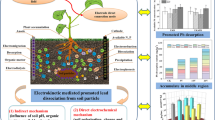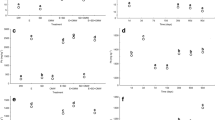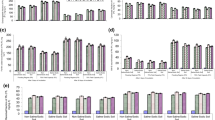Abstract
The objectives of this study were to investigate fractionation, solubility and potential bioavailability of Pb, As and Cs in Mississippi River Delta paddy soil under an electrokinetic field (EKF). Effects of EKF on soil pH changes and solid-phase distributions of metal(loid)s were examined. Results showed that fractionation of Pb, As and Cs was largely determined by the nature of elements, loading levels and EKF treatment. Native Pb in the soil was mostly in the amorphous iron oxide, organic matter and residual fractions, native As in the amorphous iron oxide, easily reducible oxide and residue fractions while native Cs in the residue fraction. Added Pb, As and Cs showed distinguished solid-phase distributions: Pb dominantly in the organic matter fraction; As in the amorphous iron oxide fraction, and Cs in the residue with a significant water-soluble plus exchangeable fraction. EKF treatment is effective on lowering soil pH to 1.5 near the anode due to water electrolysis releasing proton which is beneficial for dissolution of metal(loid)s, increasing their overall solubility. The acidification in the anode soil efficiently increased the water-soluble Pb and the exchangeable Cs, implying enhanced solubility and elevated their overall potential bioavailability in the anode region while lower solubility in the cathode area. The building up of water-soluble As in the anode region may be from electromigration of As anion from the cathode. This study shows significant enhancement of redistribution, elevated solubility and overall bioavailability of Pb, As and Cs in Mississippi Delta paddy soil under the EKF.








Similar content being viewed by others
References
Adriano DC (2001) Trace elements in terrestrial environments: biogeochemistry, bioavailability, and risks of metals, 2nd edn. Springer, New York
Altin A, Degirmenci M (2005) Lead (II) removal from natural soils by enhanced electrokinetic remediation. Sci Total Environ 337(1–3):1–10
Banin A, Navrot J, Perl A (1987) Thin-horizon sampling reveals highly localized concentrations of atmophile heavy metals in a forest soil. Sci Total Environ 61:145–152
Bolan N, Kunhikrishnan A, Thangarajan R, Kumpiene J, Park J, Makino T, Kirkham MB, Scheckel K (2014) Remediation of heavy metal(loid)s contaminated soils—to mobilize or to immobilize? J Hazard Mater 266:141–166
Cameselle C, Reddy KR (2012) Development and enhancement of electro-osmotic flow for the removal of contaminants from soils. Electrochim Acta 86:10–22
Cameselle C, Chirakkara RA, Reddy KR (2013) Electrokinetic-enhanced phytoremediation of soils: status and opportunities. Chemosphere 93(4):626–636
Davies BE (1980) Applied soil trace elements. Wiley, New York
Dermont G, Bergeron M, Mercier G, Richer-Laflèche M (2008) Soil washing for metal removal: a review of physical/chemical technologies and field applications. J Hazard Mater 152(1):1–31
Foster AL, Brown GE, Tingle TN, Parks GA (1998) Quantitative arsenic speciation in mine tailings using X-ray absorption spectroscopy. Am Mineral 83:553–568
Giannakopoulou F, Haidouti C, Chronopoulou A, Gasparatos D (2007) Sorption behavior of cesium on various soils under different pH levels. J Hazard Mater 149(3):553–556
Gommers A, Gafvert T, Smolders E, Merckx R, Vandenhove H (2005) Radio cesium soil-to-wood transfer in commercial willow short rotation coppice on contaminated farm land. J Environ Radioact 78:267-287
Han FX, Banin A (1996) Solid-phase manganese fractionation changes in saturated arid-zone soils: pathways and kinetics. Soil Sci Soc Am J 60(4):1072–1080
Han FX, Banin A (1997) Long-term transformations and redistribution of potentially toxic heavy metals in arid-zone soils. I: under saturated conditions. Water Air Soil Pollut 95(1–4):399–423
Han FX, Banin A (1999) Long-term transformations and redistribution of potentially toxic heavy metals in arid-zone soils. II: under the field capacity regime. Water Air Soil Pollut 114(3–4):221–250
Han FX, Su Y, Maruthi Sridhar BB, Monts DL (2004a) Distribution, transformation and bioavailability of trivalent and hexavalent chromium in contaminated soil. Plant Soil 265(1–2):243–252
Han FX, Kingery WL, Selim HM, Gerard PD, Cox MS, Oldham JL (2004b) Arsenic solubility and distribution in poultry waste and long-term amended soil. Sci Total Environ 320(1):51–61
Han FX, Su Y, Monts DL, Waggoner CA, Plodinec MJ (2006) Binding, distribution, and plant uptake of mercury in a soil from Oak Ridge, Tennessee, USA. Sci Total Environ 368(2–3):753–768
Han FX, Kingery WL, Hargreaves JE, Walker TW (2007) Effects of land uses on solid-phase distribution of micronutrients in selected vertisols of the Mississippi River Delta. Geoderma 142(1–2):96–103
Han FX, Shiyab S, Chen J, Su Y, Monts DL, Waggoner CA, Matta FB (2008) Extractability and bioavailability of mercury from a mercury sulfide contaminated soil from Oak Ridge, Tennessee, USA. Water Air Soil Pollut 194(1–4):67–75
Han FX, Su Y, Shi Z, Xia Y, Tian W, Philips V, Monts DL, Gu M, Liang Y (2012) Mercury distribution and speciation in floodplain soils and uptake into native earthworms (Diplocardia spp.). Geoderma 170:261–268
Huang ZY, Xie H, Cao YL, Cai C, Zhang Z (2014) Assessing of distribution, mobility and bioavailability of exogenous Pb in agricultural soils using isotopic labeling method coupled with BCR approach. J Hazard Mater 266:182–188
Iannelli R, Masi M, Ceccarini A, Ostuni MB, Lageman R, Muntoni A, Spiga D, Polettini A, Marini A, Pomi R (2015) Electrokinetic remediation of metal-polluted marine sediments: experimental investigation for plant design. Electrochim Acta 181:146–159
Jeon EK, Ryu SR, Baek K (2015) Application of solar-cells in the electrokinetic remediation of As-contaminated soil. Electrochim Acta 181:160–166
Kabata-Pendias A (2000) Trace elements in soils and plants, 3rd edn. CRC Press, Boca Raton
Kashparov V, Colle C, Zvarich S, Yoschenko V, Levchuk S, Lundin S (2005) Soil-to-plant halogens transfer studies 1. Root uptake of radioiodine by plants. J Environ Radioact 79:187-204
Kersting AB, Efurd DW, Finnegan DL, Rokop DJ, Smith DK, Thompson JL (1999) Migration of plutonium in ground water at the Nevada Test Site. Nature 397:56–59
Kim KJ, Cho JM, Beak K, Yang JS, Ko SH (2010) Electrokinetic removal of chloride and sodium from tidelands. J Appl Electrochem 40(6):1139–1144
Kim GN, Kim SS, Park UR, Moon JK (2015) Decontamination of soil contaminated with cesium using electrokinetic-electrodialytic method. Electrochim Acta 181:233-237
Lee HH, Yang JW (2000) A new method to control electrolytes pH by circulation system in electrokinetic soil remediation. J Hazard Mater 77(1–3):227–240
Lu P, Feng Q, Meng Q, Yuan T (2012) Electrokinetic remediation of chromium- and cadmium-contaminated soil from abandoned industrial site. Sep Purif Technol 98:216–220
Mandal B (2002) Arsenic round the world: a review. Talanta 58(1):201–235
Marabottini R, Stazi SR, Papp R, Grego S, Moscatelli MC (2013) Mobility and distribution of arsenic in contaminated mine soils and its effects on the microbial pool. Ecotoxicol Environ Saf 96:147–153
Nyamangara J (1998) Use of sequential extraction to evaluate zinc and copper in a soil amended with sewage sludge and inorganic metal salts. Agric Ecosyst Environ 69(2):135–141
Ottosen LM, Pedersen AJ, Hansen HK, Ribeiro AB (2007) Screening the possibility for removing cadmium and other heavy metals from wastewater sludge and bio-ashes by an electrodialytic method. Electrochim Acta 52(10):3420–3426
Pérez-Esteban J, Escolástico C, Moliner A, Masaguer A (2013) Chemical speciation and mobilization of copper and zinc in naturally contaminated mine soils with citric and tartaric acids. Chemosphere 90(2):276–283
Porter EK, Peterson PJ (1977) Arsenic tolerance in grasses growing on mine waste. Environ Pollut 14(4):255–265
Prasad PVV (2003) Plant nutrition: iron chlorosis. In: Thomas B, Murphy DJ, Murray BG (eds) Encyclopedia of applied plant sciences. Elsevier, London, pp 649–656
Pulford ID, Watson C (2003) Phytoremediation of heavy metal-contaminated land by trees—a review. Environ Int 29(4):529–540
Puppala SK, Alshawabkeh AN, Acar YB, Gale RJ, Bricka M (1997) Enhanced electrokinetic remediation of high sorption capacity soil. J Hazard Mater 55(1–3):203–220
Raskin I, Ensley BD (2000) Phytoremediation of toxic metals: using plants to clean the environment. Wiley, New York
Roane TM, Pepper LL, Gentry TL (2015) Microorganisms and metal pollutants. In: Pepper LL, Gerba CP, Gentry TJ (eds) Environmental microbiology. Academic Press, Salt Lake City, pp 415–439
Sah JG, Chen JY (1998) Study of the electrokinetic process on Cd and Pb-spiked soils. J Hazard Mater 58:301–315
Saichek RE, Reddy KR (2003) Effect of pH control at the anode for the electrokinetic removal of phenanthrene from kaolin soil. Chemosphere 51(4):273–287
Salazar MJ, Pignata ML (2014) Lead accumulation in plants grown in polluted soils. Screening of native species for phytoremediation. J Geochem Explor 137:29–36
Sheoran V, Sheoran AS, Poonia P (2009) Phytomining: a review. Miner Eng 22(12):1007–1019
Shotyk W, Norton SA, Farmer JG (1997) Summary of the workshop of peat bog archives of atmospheric metal deposition. Water Air Soil Pollut 100(3–4):213–219
Smith E, Naidu R, Alston AM (1998) Arsenic in the soil environment: a review. Adv Agron 64:149–195
Tessier A, Campbell PGC, Bisson M (1979) Sequential extraction procedure for the speciation of particulate trace metals. Anal Chem 51(7):844–851
Thangavel PSC (2004) Phytoextraction: role of hyperaccumulators in metal contaminated soils. Proc Indian Natl Sci Acad 70(1):109–130
Virkutyte J, Sillanpää M, Latostenmaa P (2002) Electrokinetic soil remediation—critical overview. Sci Total Environ 289(1–3):97–121
Wu L, Luo Y, Xing X, Christie P (2004) EDTA-enhanced phytoremediation of heavy metal contaminated soil with Indian mustard and associated potential leaching risk. Agric Ecosyst Environ 102(3):307–318
Yang GC, Lin SL (1998) Removal of lead from a silt loam soil by electrokinetic remediation. J Hazard Mater 58(1–3):285–299
Yasunari TJ, Stohl A, Hayano RS, Burkhart JF, Eckhardt S, Yasunari T (2011) Cesium-137 deposition and contamination of Japanese soils due to the Fukushima nuclear accident. Proc Natl Acad Sci 108(49):19530–19534
Yeung AT, Gu YY (2011) A review on techniques to enhance electrochemical remediation of contaminated soils. J Hazard Mater 195:11–29
Yeung A, Gu Y (2012) Use of chelating agents in electrochemical remediation of contaminated soil. In: Tsang DCW, Lo IMC, Surampalli RY (eds) Chelating agents for land decontamination technologies. American Society of Civil Engineers, Reston, pp 212–280
Zhao S, Lian F, Duo L (2011) EDTA-assisted phytoextraction of heavy metals by turfgrass from municipal solid waste compost using permeable barriers and associated potential leaching risk. Bioresour Technol 102(2):621–626
Acknowledgments
This research was supported by U.S. Nuclear Regulatory Commission (NRC-HQ-84-15-G-0042 and NRC–HQ-12-G-38-0038) and U.S. Department of Commerce (NOAA) (NA11SEC4810001-003499). Mr. Mao was also supported by China Scholarship Council, Jiangsu Scientific Research Innovation Program of Ordinary Higher Education Graduate (KYZZ0156), Special Fund for Hydro-scientific Research in the Public Interest (201301017), and the Fundamental Research Fund for the Central Universities (2014B04814 and 2015B05814).
Author information
Authors and Affiliations
Corresponding author
Abbreviations
- EKF
-
Electrokinetic field
- EKR
-
Electrokinetic remediation
- SOL
-
The water-soluble fraction
- EXC
-
The exchangeable fraction
- ERO
-
The easily reducible oxide bound fraction
- AmoFe
-
Amorphous iron oxide bound fraction
- OM
-
Organic matter bound fraction
- CryFe
-
Crystalline iron oxide bound fraction
- RES
-
Residual bound fraction
- SSD
-
Selective sequential dissolution
- ICP-MS
-
Inductively coupled plasma mass spectrometry
Rights and permissions
About this article
Cite this article
Mao, X., Han, F.X., Shao, X. et al. The distribution and elevated solubility of lead, arsenic and cesium in contaminated paddy soil enhanced with the electrokinetic field. Int. J. Environ. Sci. Technol. 13, 1641–1652 (2016). https://doi.org/10.1007/s13762-016-1007-2
Received:
Revised:
Accepted:
Published:
Issue Date:
DOI: https://doi.org/10.1007/s13762-016-1007-2




